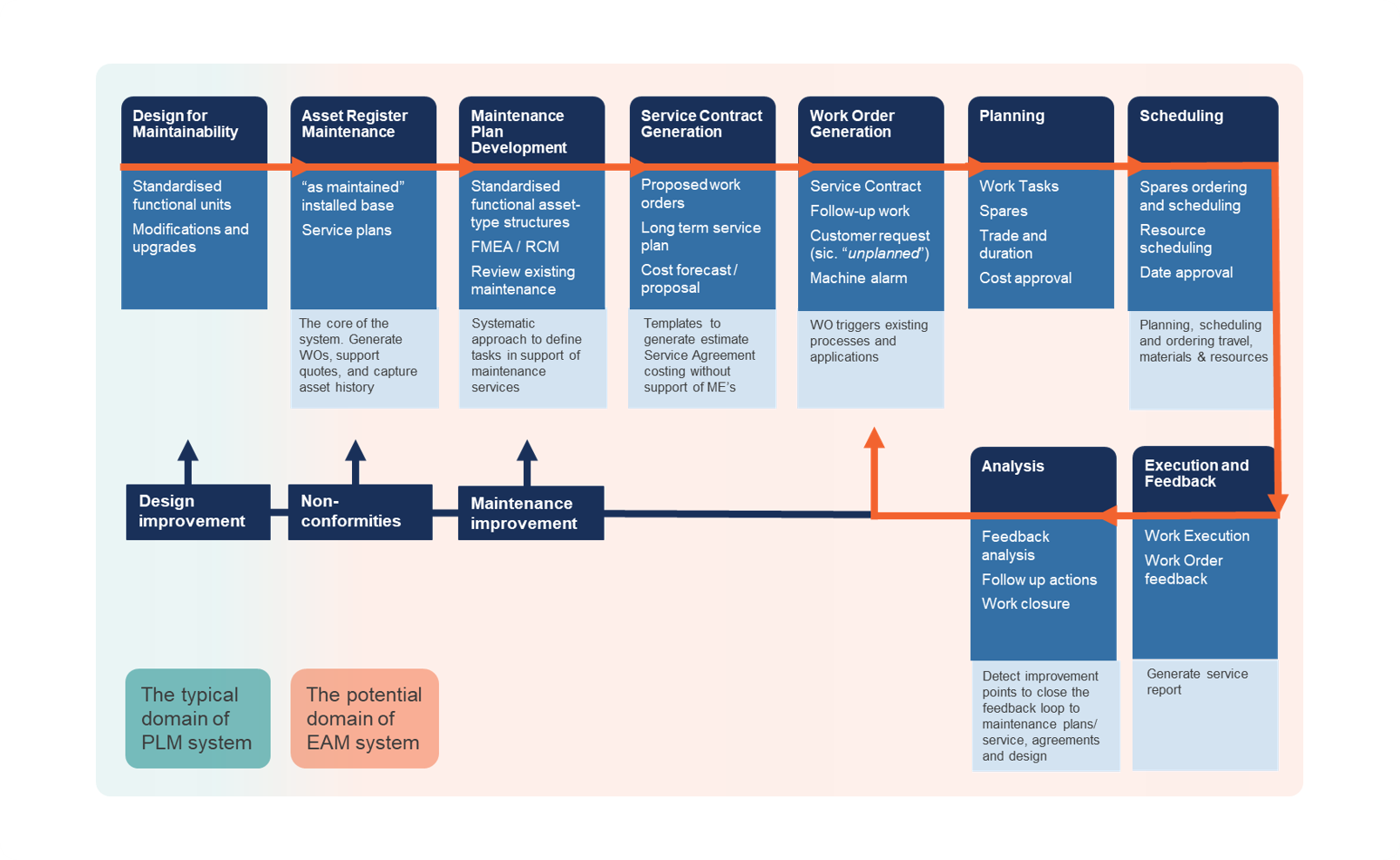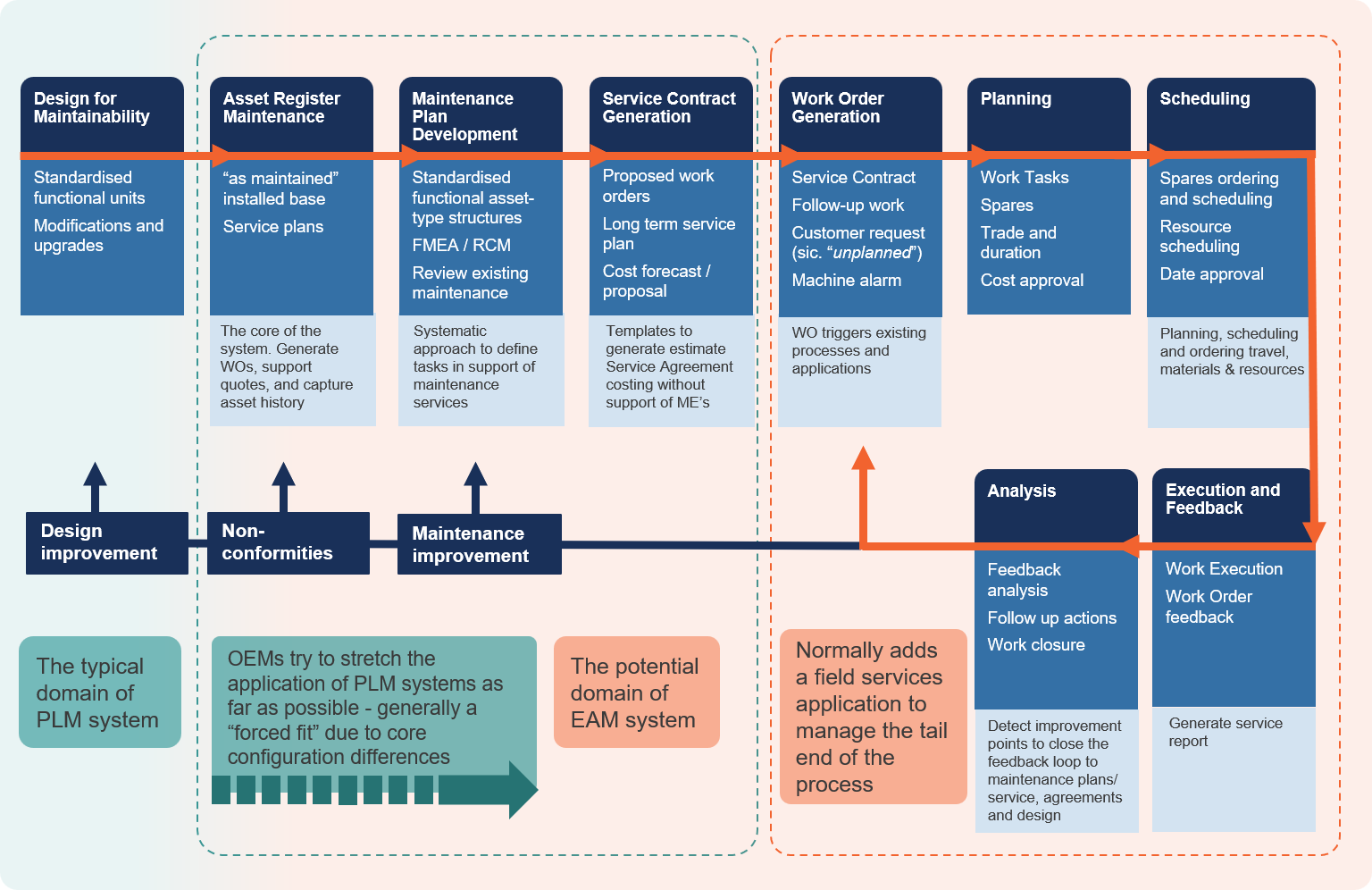Author | Stefan Terblanche, Pragma Partner Consultant
Original Equipment Manufacturers (OEMs) face many challenges when it comes to providing effective and efficient after-sales service to their clients. The typical OEM after-sales business process, as shown in the following diagram, consists of several activities that need to be performed. For an OEM to be efficient in delivering its services, appropriate tools and technology need to be applied to streamline and automate this process and the supporting activities.

Any manual process might be sufficient with only a few standard equipment models consisting of a handful of components. But applying this process to multiple equipment types and multiple variants, each consisting of hundreds of components, quickly becomes a complex challenge. Some considerations to keep in mind:
Where to manage the installed base?
OEMs use a Product Lifecycle Management (PLM) system to manage their design and manufacturing processes, providing a detailed bill of material of a specific item of equipment leaving the factory. But this equipment gets installed at a specific client, maintained and sometimes modified over time. Although the name suggests it, in practice, the PLM system is not effective in managing the installed base of the OEM at the client. So where should it be managed?
How to create a service contract quote?
If a client requests a quotation from the OEM for a service contract or the cost of a specific service, the OEM needs to be able to produce such a quote effectively. Many OEMs still rely on sending an experienced technician to do a physical inspection, gathering enough information to be able to create a quote. Often the most experienced technicians are required to perform this work, limiting their time to perform actual work or train new field technicians. It is a time-consuming and inefficient process, with clients expecting OEMs to have the appropriate insights to generate accurate service quotes as a standard process. This implies the OEM understands the specific installed base at the client, the maintenance tasks that need to be performed, the parts that need to be changed, and the labour required to perform the work. When an OEM has thousands of items of equipment installed at client sites across the globe, an appropriate software tool becomes essential to provide the insight to deliver a professional after-sales service.
How to control the execution of the service contract?
Field technicians and spares are expensive resources, and they need to be managed carefully to ensure the OEM delivers the service efficiently. What needs to be done at which client, and what spares and resources are required? Many OEMs opt to implement a standalone field service application to control the work management loop at the end of the after-sales process, but this results in integration issues with the installed base and source of the maintenance recommendations and service contracts.
How to close the feedback loop from the field to the R&D and after-sales departments?
Closing the feedback loop, connecting what happens in the field to the R&D and after-sales departments, is essential for building a continuous improvement system that will maintain the installed base and give maintenance recommendations and performance history to the engineering and R&D teams.

The EAM, an essential part of the system landscape of after-sales services
An Enterprise Asset Management System (EAMS) is pivotal in enabling an OEM to address these challenges. It acts as the linchpin for managing data, streamlining processes, and optimising service delivery. With a robust EAMS, OEMs gain control over the operational phase of their equipment after leaving the factory in one application. The role and function of an EAMS should include:
- Managing the installed base as used at the client site, including the bill of material
- Developing and configuring maintenance recommendations and managing their application across different models and revisions in a centralised place
- Identifying and grouping spares kits that can be sold to clients for major services
- Managing the equipment manuals and specifications for the various models and revisions in a central place
- Rolling out design improvement to all clients with the same equipment, offering a specific upgrade kit or assembly
- Generating client-specific service quotes in support of contract sales or ad hoc requests, and including the carbon footprint of the intervention
- Enabling the effective warranty management of equipment and components
- Creating and controlling work orders through the entire field service process, including planning and scheduling of resources
- Driving work execution standards from a technical and safety perspective
- Validating feedback of the work performed
- Using the feedback received to trigger changes to the installed base, maintenance recommendations and even the design
- Recording all client interactions related to the equipment in a single place
- Obtaining full insights into all after-sales activities through the measurement and reporting of KPIs in support of performance and profitability improvement
- Creating a body of knowledge for after-sales services, reducing the risk of being dependent on only a few very experienced and knowledgeable field technicians.
In conclusion, a centralised EAMS is instrumental in enhancing a service culture and helping OEMs manage their installed base efficiently. OEMs can face their challenges head-on and lay a strong foundation for revenue growth, ensuring their clients receive the best possible after-sales services.

